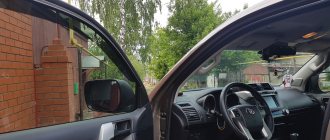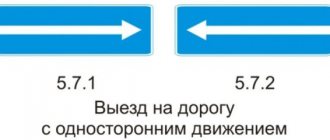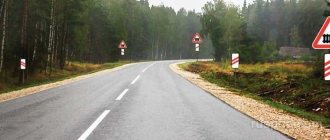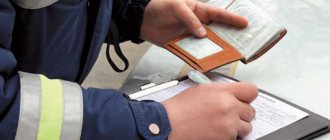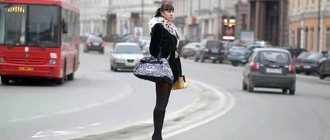Traffic rules for trams are slightly different than for cars, despite the fact that they travel on roads that intersect with cars and pedestrians. And more often than not, rail transport has an advantage, but not always.
In most cases, cars should allow the opponent to pass. And yet there are cases when a tram must give way to a car:
- at an intersection where traffic is regulated by a traffic light, if a rail vehicle is moving in the direction indicated by the arrow on the additional section, it must be turned on simultaneously with the yellow or red signal, and the car must move to the green light;
- at an intersection where there is no traffic light, but there is a distinction between the main and secondary roads - a tram moving along the secondary road must allow a car to pass;
- when a rail vehicle leaves the depot;
- when encountering an emergency vehicle with beacons and a sound siren; when entering a roundabout intersection.
If a car and a rail vehicle traveling along perpendicular tracks meet at a controlled intersection, the latter sometimes has to wait. According to the rules, the tram is obliged to allow the car to complete the turn or pass through this zone if it has already begun the maneuver. And only then drive under the green light.
The tram must give way to a pedestrian in the following cases:
- if a vehicle traveling on rails makes a turn, it must first let a pedestrian or cyclist pass;
- if a rail vehicle is at a controlled intersection and the red light is on, you can go after the green one when people have finished moving;
- if you approach a crossing without a traffic light or a traffic controller;
- if a rail vehicle approaches a pedestrian crossing regulated by a traffic light;
- if he sees a blind pedestrian (with a white cane) on the roadway;
- if a person is in a hurry to a public transport stop, having just left such a bus or minibus;
- if these are children who are walking across the roadway towards a vehicle with a “Transportation of Children” sign, the bus or car must be parked with the emergency lights on.
Which driver must give way to the tram:
- a motorist, if the car and the rail vehicle are at a controlled intersection;
- a motorist if his vehicle is traveling in the same direction as his opponent at an intersection of unequal paths;
- a motorist, if he and a second participant in the movement find themselves at the intersection of equivalent paths, the trackless vehicle yields in any case, even when it itself approaches the opponent on the right.
The situations listed also apply to those who drive a motorcycle, moped, tractor, bicycle, or truck.
Also, the tram must give way if:
- there is a railway crossing on its way, the first to cross it is a train, a locomotive or a handcar;
- at a controlled intersection there are two rail vehicles of the same type - the one going right or straight has priority;
- At an unregulated intersection of roads of equal importance, there are two trams; the one approaching the second one from the right must go first, but both rail vehicles must travel along the main road or in the same train along the secondary road.
More on InDrive.Net:
Key points on how to cross the road correctly
A fine of 1,500 rubles is provided for violators. under Article 12.13 of the Code of Administrative Offences.
Read more in our article about in what cases a tram must give way.
In this article:
What does the traffic regulations say?
Any relationships that arise between participants on domestic roads are certainly regulated by a central set of regulations called the Russian Federation Traffic Regulations. Therefore, all vehicle owners should periodically re-read the collection of rules, refreshing their memory of proper driving. Although in the said document, in principle, the term “tram tracks” itself is absent.
It must be additionally emphasized that the rails are not a priori considered a component part of the roadway, but are a separate element of the road. Such routes were not originally designed for the movement of other vehicles, so going there has clear taboos and transportation through them is stipulated by separate regulations.
Here the main law leads to the central recommendation - maximum comfort for others, which is legally reflected in clause 9.6, which states that driving is permitted on rails only in the same direction as the driver is moving. A similar scenario is acceptable when the remaining lanes are occupied and the adjacent clause 8.5 of the traffic rules is not violated at the same time. It is important to remember that at intersections with tram tracks, it is worth taking the right position.
According to standard rules, the driver has the right to use this zone to achieve his own goals only if the rails are on the left side of the roadway, in the same direction as the car. Another important condition is that the paths of this transport must be at the same level as the road.
The advantage of a tram on a road with tram tracks
It should be clearly understood that a tram always has a tangible advantage over other representatives of trackless options, except for 3 cases when:
- Moves to the arrow active in the additional section in parallel with the red or yellow traffic light signal.
- Approaches the intersection along a secondary road.
- Leaves the depot.
The first point relates to the intersection of regulated areas, the second - to the movement of uncontrolled intersections, here is the third scheme - when a tram leaves a station where repairs were made, it must give way to any other means of transportation.
What do you need to know when approaching a tram stop?
Based on statistics, the most dangerous areas of the road, in the center of which tram tracks are located, are the stops, so the driver of the car needs to assess the situation in advance and decide: should he give way to the tram/pedestrians or not?
When a special “island” for waiting for public transport is not installed in the area in question, passengers wait for the tram to arrive on the sidewalk. And as soon as he arrived and stopped, citizens have the right to cross the roadway without fear, and drivers are obliged to brake to let them through. It is necessary to focus primarily on people, and not to monitor whether the tram doors are open.
When there is still a special “island” in the stopping area, future passengers look for transport there, and no other additional barriers to traffic should be created. When people are crossing the roadway, it is worth remaining vigilant, because not all pedestrians know and adhere to the traffic rules of the Russian Federation, but the driver is always responsible, since he is behind the wheel.
Tram tracks at a traffic light-controlled intersection
In this case, the passage of the intersection is regulated by paragraph 13.6 of the traffic rules:
13.6. If traffic lights or traffic controller signals allow the movement of a tram and trackless vehicles at the same time, then the tram has priority regardless of the direction of its movement. However, when moving in the direction of the arrow turned on in the additional section simultaneously with a red or yellow traffic light, the tram must give way to vehicles moving from other directions.
In most cases, at intersections regulated by traffic lights, rail vehicles have priority trams .
The only exception to this rule is the situation when the tram turns under the green arrow turned on in the additional section at the same time as the red or yellow signal. In this case, car drivers have an advantage. This is exactly the situation shown in the picture above, where a tram gives way to blue and white cars.
Please note that if the car and the tram are moving from different directions (as in the figure above), then the driver of the car cannot determine whether the tram is going to the green signal in the additional section or to the regular green signal.
If we look at the situation from the other side and evaluate the consequences of an accident for the tram driver and the car driver, it becomes obvious that the car driver is always a loser, because The car suffers significant damage due to its low weight. An example of such an accident is presented in the video:
Tweet
The only conclusion that can be drawn from all of the above is that at intersections regulated by traffic lights, you should always give way to a tram that has started moving.
In what cases is it permitted to travel on passing tram tracks?
To begin with, it is extremely important to highlight clause 9.6 in the general collection of rules, which clearly defines suitable conditions that allow car drivers to move on rails:
- the tram lane runs parallel to the curb on the left side of the road in the same direction of travel;
- a detour is carried out to overcome an obstacle or due to road congestion (traffic jams, a huge number of other cars);
- a situation where it is absolutely necessary to make a left turn or turn the vehicle around completely.
Regardless of the reason, which boils down to one of the mentioned schemes, while on a tram line, car owners should not deliberately (out of ignorance) interfere with other traffic participants: classic rules do not allow occupying the tracks without a good reason.
What about oncoming rails?
It is worth immediately noting for all drivers that in this case, when turning, “oncoming traffic” is not allowed, so this situation falls into the category of strict prohibitions. Considering that, according to the rules of traffic rules of the Russian Federation, a U-turn is a full-fledged type of maneuver that changes the movement of traffic in the opposite direction, then you need to remain as careful as possible here. In practice, the oncoming lane can be used before or after the turn, but not directly during the maneuver itself.
It is necessary to note that when you are at an intersection where the rails change direction, such a ban is duplicated to any extent: it extends its effect to tram tracks with a bend, and the border between the intersection and the exit is quite ambiguous. Therefore, drivers should cross oncoming traffic only when it is possible to achieve a maneuver angle as close to 90 degrees as possible.
If we compare a U-turn at a controlled intersection and outside a given area, then in these situations, driving onto oncoming tram tracks is strictly prohibited according to Russian traffic rules.
At the crossroads
Analyzing the context of domestic traffic requirements and the very concept of “intersection” at various levels, specific cross-traffic through overpasses or tunnels is invariably implied. Even in paragraph 9.6. the term “level” should be taken literally when access to the rails is not limited and the coverage in the said area coincides with the condition of the roadway or differs only to an insignificant extent.
Thus, road designations 5.15.1 or 5.15.2 impose significant restrictions on transportation through the intersection along tram tracks. Here the driver must move to the lane before the exit to comply with all the recommendations of the signs located on the road.
In order to navigate through an intersection with nearby tram tracks without serious mistakes, you need to clearly understand which road the main traffic is on (main or secondary) , and whether it is regulated in a special mode.
When a certain intersection is controlled, the order of passage is determined solely by the characteristic signal of the installed traffic light. A driver planning to turn left or make a detour must certainly give way to the tram, as well as cars moving towards or to the right.
When a traffic light has an additional section in the format of an additional arrow, in a direction parallel to the activation of the yellow and red signals, then drivers of cars and trams are required to give way to vehicles moving on the other side. When the traffic controller allows a tram and a car to travel at the same time in the absence of the flashing arrow mentioned above, then the tram has advantages over the car, regardless of which route it follows.
In some situations, where the owner of the vehicle does not have the opportunity to figure out which road he is on, due to night time or difficult weather conditions, and there are no priority markers at all, he can drive the car, believing that he is driving on a secondary route. movements.
Movement along passing paths
Traffic on tram tracks in the same direction is legal in the following cases:
- A U-turn, a turn to the left across tram tracks, when signs and markings do not require you to take the extreme left position on the road in the designated lane. The driver has to prepare for the maneuver by waiting for a traffic light or allowing oncoming traffic to pass, and move along the same rails for some time.
- Staying ahead of the flow of cars or avoiding obstacles, if this does not interfere with the rail vehicle.
So, a driver can drive on passing rails when all lanes in his direction are occupied, wants to overtake a vehicle (even overtake twice or more), when it is necessary to turn left or turn around from the extreme left position.
You should always pay attention to the markings and signs that indicate how many lanes there are on the road and from which lanes you are allowed to maneuver.
In what cases must a tram give way?
Sometimes circumstances on domestic roads are such that lack of time forces some drivers to make rather dangerous maneuvers. Although the standard rules in the updated version allow driving straight along the tram tracks when there is a traffic jam on the common road for ordinary cars. But at the same time, certain conditions must be observed:
- The driver’s actions must not create unforeseen interference with the adjacent movement of the public tram.
- The rail bed must adhere to the same direction and be exactly level or only slightly deviate from the road.
- It is allowed to drive when there are no signs in front of the intersection 5.15.1. “Direction of transportation along lanes” and 5.15.2. "Direction of movement along the lane."
However, if special road markings (a solid line or any other designation regulating the directions of driving along the lanes) do not interfere with access to the rail tracks, then the driver can cross the section of road traffic in question without obstacles.
To the car
Theoretically, in almost any situation the tram moves first, and there are only 3 exceptions to the general rules if:
- the car is driving along the main road, and the tram is driving along the secondary road (this situation is 100% subject to the rule that the driver is obliged to give way to someone moving on the main road);
- the vehicle can move freely due to the green traffic light signal, and for the tram only a single-color arrow functions in parallel with the red or yellow signal;
- the car is moving along the road, and the tram car is just starting to leave the depot (this scheme was also mentioned earlier and is a kind of exception to the general rules).
Having carefully understood in what situations a tram gives way to another car, problems and emergency situations in traffic should not arise a priori.
Pedestrian
According to the rules, there are many situations when a tram driver must give way not only to other cars, but also to ordinary pedestrians, if:
- The vehicle following the rails makes a turn, then it must begin to let a pedestrian or cyclist pass in front of it.
- The tram has entered a controlled intersection, then after the green one you can only go when people have completely stopped moving.
- You are approaching a special crossing zone without an installed traffic light or traffic controller.
- Rail transport approaches a pedestrian crossing controlled by other devices.
- A blind citizen (pedestrian with a white cane) is visible on the roadway or on the way to it.
- A person hurries to a stop of another public transport, having just left a bus or minibus.
Separately, it is worth considering such a problematic area when there are children crossing the roadway with a “Transportation of Children” sign, and the bus or the car receiving them should be no less noticeable due to the included emergency lights.
Uneven intersection with tram tracks
Driving through unregulated unequal intersections with tram tracks is described by several points of the traffic rules. First, let's look at all of the above points:
13.9. At the intersection of unequal roads, the driver of a vehicle moving on a secondary road must give way to vehicles approaching on the main road, regardless of the direction of their further movement.
At such intersections, a tram has an advantage over trackless vehicles moving in the same or opposite direction on an equivalent road, regardless of the direction of its movement.
13.10. In the event that the main road changes direction at an intersection, drivers moving along the main road must follow the rules for driving through intersections of equivalent roads. Drivers driving on secondary roads should follow the same rules.
13.11. At the intersection of equivalent roads, with the exception of the case provided for in paragraph 13.111 of the Rules, the driver of a trackless vehicle is obliged to give way to vehicles approaching from the right. Tram drivers should follow the same rule among themselves.
At such intersections, the tram has priority over trackless vehicles, regardless of the direction of its movement.
13.111. When entering an intersection where there is a roundabout and which is marked with sign 4.3, the driver of the vehicle is obliged to give way to vehicles moving along such an intersection.
Based on the above points, the following conclusions can be drawn:
1. If a tram approaches the intersection on a secondary road, and your car on the main road, then the tram must give way to the car. The situation is shown in the figure below, where a tram gives way to an orange car located on the main road.
I note that the tram driver, who has been turned by the enormous weight of his vehicle, may not want to give way to your “tiny car.” So, in this case, you should not crawl under the tram, even if you are completely sure that during the subsequent analysis of the accident, the truth will be on your side.
2. In all situations except the one described above, a tram at an unequal intersection has an advantage over cars, so it should give way.
When must a driver give way to a tram?
Any driver intending to make a left turn and cross the tram rails is required by law to act in the following way: make sure that no one is on the tracks (trams or other cars), then turn on the desired turn signal and only then enter the desired line. Next, you must give way to others and complete the maneuver.
When in the process of driving there is a road sign indicating the direction of driving along the lanes (5.15.1 and 5.15.2), this pattern is allowed to be repeated only on the side left side of the roadway, and you should not drive directly onto the tram line. Even clause 8.11 fixes versions when it is impossible to deploy in this way. Considering that this ban on driving on rails is not duplicated, it is permissible to make a U-turn at an intersection where tram tracks intersect.
Moreover, the turning trajectory is also reflected in clause 8.5 of the same recommendations: any manipulations by the driver are similar to repeating a turn while crossing a tram track. If there are direction signs, the turn occurs from the far left side of the road. But it is worth remembering that, based on the turning radius of the vehicle and its dimensions, you need to start in your calculations from the far right part of the lane (curb).
Fines for violation
The law of the Russian Federation clearly establishes the legal liability of road users for offenses in this area, therefore, for an accident that occurs on tram tracks, the driver is entitled to administrative and criminal prosecution:
- According to Article 12.24 of the Code of Administrative Offenses of the Russian Federation, there is a fine of up to 25 thousand rubles. or restriction of freedom for up to 2 years;
- according to Art. 264 of the Criminal Code of the Russian Federation provides for sanctions of up to 9 years (depending on the consequences of the incident).
In turn, an attempt to enter the path of an oncoming road entails a liability of 5 thousand rubles. or deprivation of rights for up to six months under Part 4 of Art. 12.15 Code of Administrative Offenses of the Russian Federation. And if the driver does not drive onto the side left side of the rails while making a planned left turn, he faces a simplified option - a simple warning or a fine of 500 rubles. according to Part 1.1 of Art. 12.14 Code of Administrative Offenses of the Russian Federation.
| Did not find an answer to your question? Call a lawyer! Moscow: +7 (499) 110-89-42 St. Petersburg: +7 (812) 385-56-34 Russia: +7 (499) 755-96-84 |
Punishment will also follow for downtime (causing a traffic jam involving a tram) due to obstruction: in this case, a warning or financial liability in the amount of 500 rubles will be imposed. referring to Part 3 of Art. 12.14 Code of Administrative Offenses of the Russian Federation. But when, during the passage of a controlled intersection, a similar obstacle was also created to the tram, which has the right of way, then more serious sanctions of 1 thousand rubles are provided. according to Part 2 of Art. 12.13 Code of Administrative Offenses of the Russian Federation.
